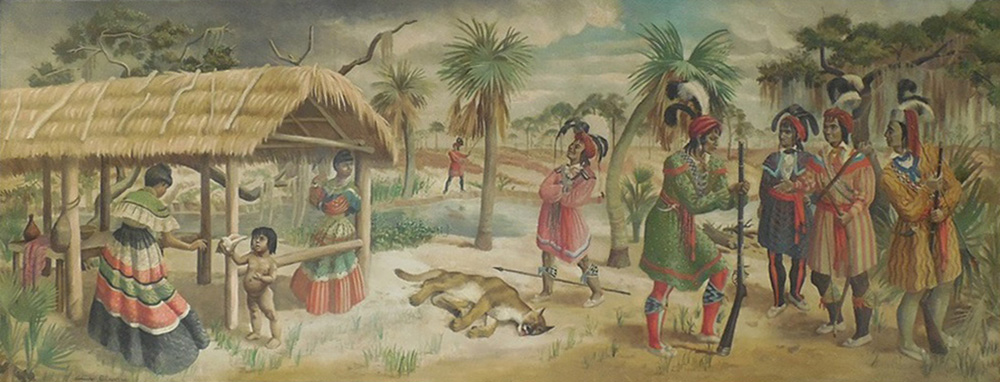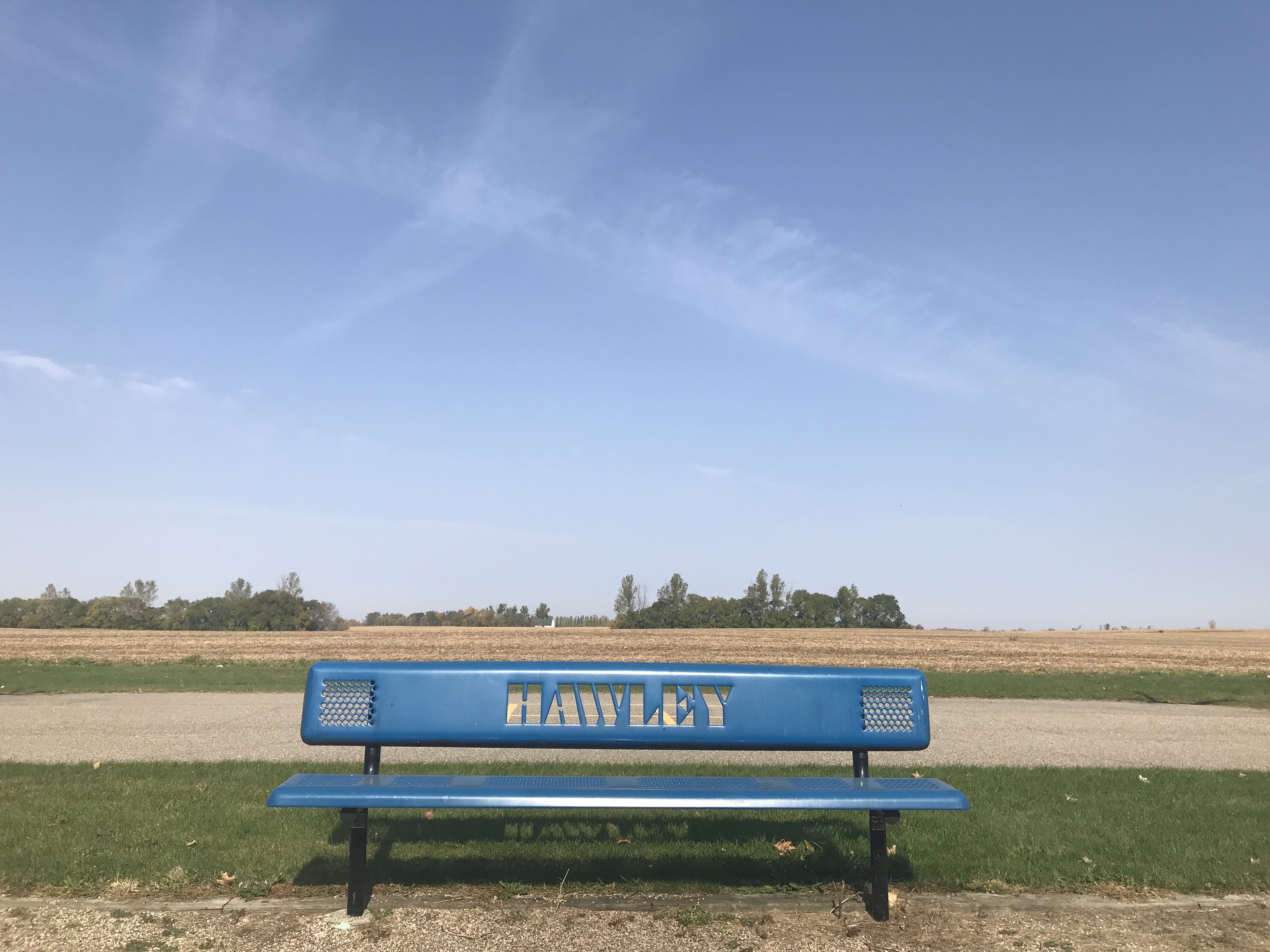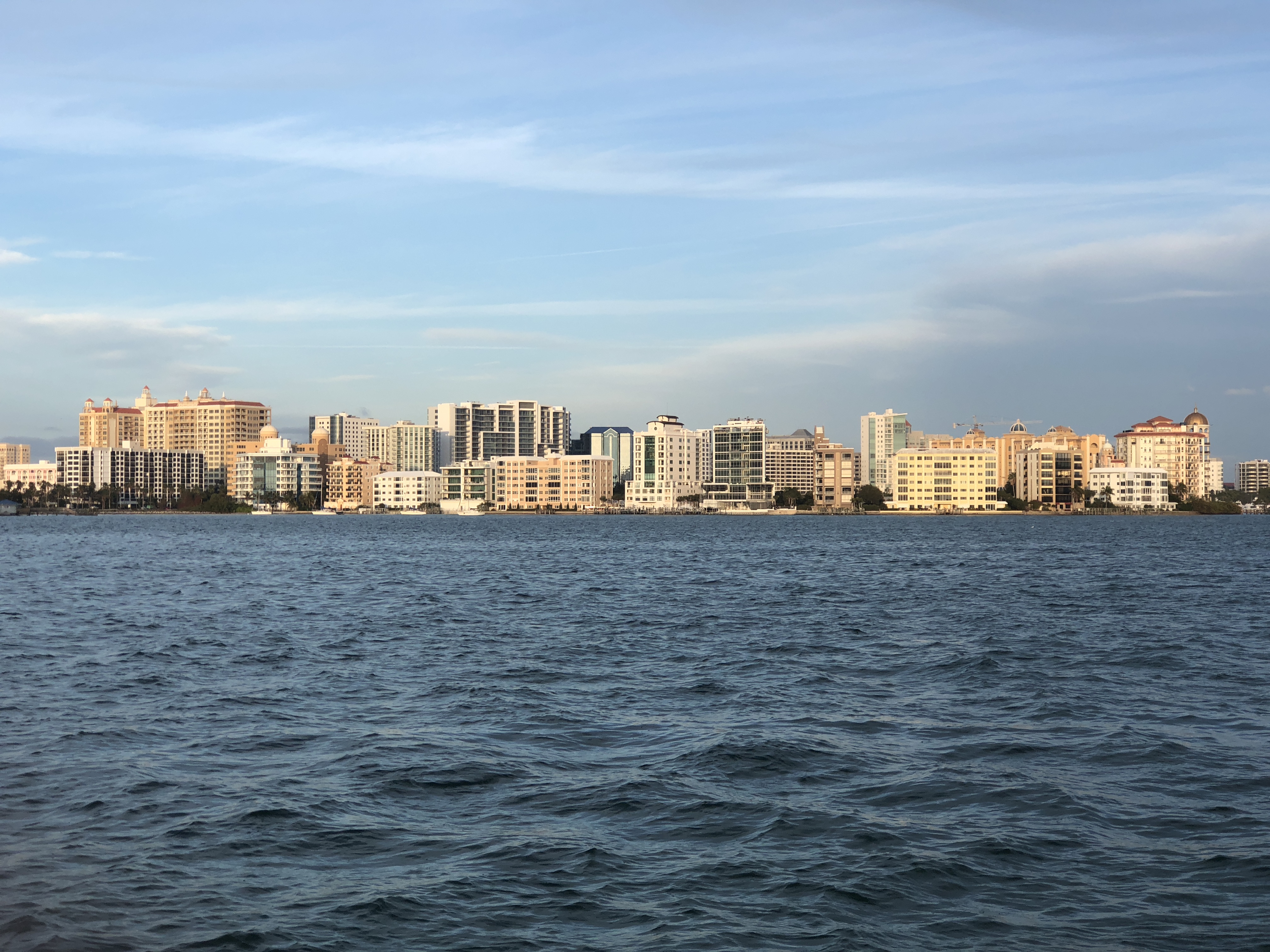|
Lucile Blanch
Lucile Esma Lundquist Blanch (December 31, 1895 – October 31, 1981) was an American artist, art educator, and Guggenheim Fellow. She was noted for the murals she created for the U.S. Treasury Department's Section of Fine Arts during the Great Depression. Early life and education Lucile Lundquist Blanch was born in 1895 in Hawley, Minnesota to Charles E. and May E. Lundquist. Raised in rural northern Minnesota, Blanch enjoyed gardening as a child. Her mother, a gifted musician, insisted on young Blanch starting strict piano lessons at age 7, though Blanch would eventually protest her lessons at 12 years old. After grade school, Blanch's mother signed her up for "teachers college," which she attended briefly before writing a 12-page letter (front and back) to her parents describing her desire to go to art school. At the Minneapolis School of Art, she and future husband Arnold Blanch studied with notable artists like Harry Gottlieb and Adolf Dehn. From 1918, she studied with ... [...More Info...] [...Related Items...] OR: [Wikipedia] [Google] [Baidu] |
Hawley, Minnesota
Hawley is a town in Clay County, Minnesota, United States, along the Buffalo River. The population was 2,219 at the 2020 census. The town went through six quick name changes after 1871 until, in 1872, it was finally named after Thomas Hawley Canfield, an officer in the Northern Pacific Railway, which laid out the town. General Custer visited the town in 1876. The incident was recalled in a short film entitled Incident at Hawley by WCCO Television in Minneapolis that aired during America's bicentennial year of 1976. In 2007, the town started an ad campaign called "Hawley Would" (a homophonic play on words of "Hollywood"). The campaign focuses on both the small-town atmosphere of Hawley and its proximity to the Fargo-Moorhead metropolitan area; Hawley is 22 miles from downtown Fargo. Hawley was at one time settled by a colony of immigrants from Yeovil, Somerset; among these was Elisabeth Chant, later to become a painter in Minneapolis. Geography Hawley is east of Moorhea ... [...More Info...] [...Related Items...] OR: [Wikipedia] [Google] [Baidu] |
Osceola Holding Informal Council With His Chiefs
Osceola (1804 – January 30, 1838, Asi-yahola in Creek), named Billy Powell at birth in Alabama, became an influential leader of the Seminole people in Florida. His mother was Muscogee, and his great-grandfather was a Scotsman, James McQueen. He was reared by his mother in the Creek (Muscogee) tradition. When he was a child, they migrated to Florida with other Red Stick refugees, led by a relative, Peter McQueen, after their group's defeat in 1814 in the Creek Wars. There they became part of what was known as the Seminole people. In 1836, Osceola led a small group of warriors in the Seminole resistance during the Second Seminole War, when the United States tried to remove the tribe from their lands in Florida to Indian Territory west of the Mississippi River. He became an adviser to Micanopy, the principal chief of the Seminole from 1825 to 1849. [...More Info...] [...Related Items...] OR: [Wikipedia] [Google] [Baidu] |
Works Progress Administration
The Works Progress Administration (WPA; renamed in 1939 as the Work Projects Administration) was an American New Deal agency that employed millions of jobseekers (mostly men who were not formally educated) to carry out public works projects, including the construction of public buildings and roads. It was set up on May 6, 1935, by presidential order, as a key part of the Second New Deal. The WPA's first appropriation in 1935 was $4.9 billion (about $15 per person in the U.S., around 6.7 percent of the 1935 GDP). Headed by Harry Hopkins, the WPA supplied paid jobs to the unemployed during the Great Depression in the United States, while building up the public infrastructure of the US, such as parks, schools, and roads. Most of the jobs were in construction, building more than 620,000 miles (1,000,000 km) of streets and over 10,000 bridges, in addition to many airports and much housing. The largest single project of the WPA was the Tennessee Valley Authority. At its pea ... [...More Info...] [...Related Items...] OR: [Wikipedia] [Google] [Baidu] |
Philip Evergood
Philip Howard Francis Dixon Evergood (born Howard Blashki; 1901–1973) was an American painter, etcher, lithographer, sculptor, illustrator and writer. He was particularly active during the Depression and World War II era. Life Philip Evergood was born in New York City. His mother was English and his father, Miles Evergood, was an Australian artist of Polish Jewish descent who, in 1915, changed the family's name from Blashki to Evergood. Philip Evergood's formal education began in 1905. He studied music and by 1908 he was playing the piano in a concert with his teacher.Who Was Who in American Art, Soundview Press 1999, Evergood, Philip He attended different English boarding schools starting in 1909 and was educated mainly at Eton and Cambridge University. In 1921 he decided to study art, left Cambridge, and went to London to study with Henry Tonks at the Slade School. In 1923 Evergood went back to New York where he studied at the Art Students League of New York for a year. ... [...More Info...] [...Related Items...] OR: [Wikipedia] [Google] [Baidu] |
Sarasota, Florida
Sarasota () is a city in Sarasota County on the Gulf Coast of the U.S. state of Florida. The area is renowned for its cultural and environmental amenities, beaches, resorts, and the Sarasota School of Architecture. The city is located in the southern end of the Greater Tampa Bay Area and north of Fort Myers and Punta Gorda. Its official limits include Sarasota Bay and several barrier islands between the bay and the Gulf of Mexico. Sarasota is a principal city of the Sarasota metropolitan area, and is the seat of Sarasota County. According to the 2020 U.S. census, Sarasota had a population of 54,842. The Sarasota city limits contain several keys, including Lido Key, St. Armands Key, Otter Key, Casey Key, Coon Key, Bird Key, and portions of Siesta Key. Longboat Key is the largest key separating the bay from the gulf, but it was evenly divided by the new county line of 1921. The portion of the key that parallels the Sarasota city boundary that extends to that new county l ... [...More Info...] [...Related Items...] OR: [Wikipedia] [Google] [Baidu] |
Ringling College Of Art And Design
Ringling College of Art and Design (RCAD) is a private art and design school in Sarasota, Florida. It was founded by Ludd M. Spivey as an art school in 1931 as a remote branch of Southern College but separated by 1933. History The origins of the college go back to when the President of Southern College (which is now called Florida Southern College) Dr. Ludd M. Spivey wanted to get the support of John Ringling for his college. Spivey learned that Ringling did not have an interest in helping Southern College, was almost broke and wanted to start his own art school on the grounds of his museum. The two discussed the idea of creating an art college before reaching the agreement that they would open the school in Sarasota as a branch of Florida Southern. The School of Fine and Applied Art of the John and Ringling Art Museum was founded on March 31, 1931. It opened on October 2 with 75 registered students. It was a campus of Southern College functioning initially as a junior colle ... [...More Info...] [...Related Items...] OR: [Wikipedia] [Google] [Baidu] |
Washington, D
Washington commonly refers to: * Washington (state), United States * Washington, D.C., the capital of the United States ** A metonym for the federal government of the United States ** Washington metropolitan area, the metropolitan area centered on Washington, D.C. * George Washington (1732–1799), the first president of the United States Washington may also refer to: Places England * Washington, Tyne and Wear, a town in the City of Sunderland metropolitan borough ** Washington Old Hall, ancestral home of the family of George Washington * Washington, West Sussex, a village and civil parish Greenland * Cape Washington, Greenland * Washington Land Philippines * New Washington, Aklan, a municipality *Washington, a barangay in Catarman, Northern Samar *Washington, a barangay in Escalante, Negros Occidental *Washington, a barangay in San Jacinto, Masbate *Washington, a barangay in Surigao City United States * Washington, Wisconsin (other) * Fort Washington (disambigu ... [...More Info...] [...Related Items...] OR: [Wikipedia] [Google] [Baidu] |
Corcoran Gallery Of Art
The Corcoran Gallery of Art was an art museum in Washington, D.C., United States, that is now the location of the Corcoran School of the Arts and Design, a part of the George Washington University. Overview The Corcoran School of the Arts & Design at George Washington University (part of the Columbian College of Arts and Sciences) hosts exhibitions by its students and visiting artists and offers degrees in Fine Art, Photojournalism, Interaction Design, Interior Architecture, etc. Prior to the Corcoran Gallery of Art's closing, it was one of the oldest privately supported cultural institutions in the United States. Starting in 1890, the Corcoran School with 40 students and two faculty members, later known as the orcoran College of Art + Design in the 1990s co-existed with the gallery. The museum's main focus was American art. In 2014, after decades of financial problems and mismanagement, the Corcoran was dissolved by court order. A new non-profit was established by the Trustees ... [...More Info...] [...Related Items...] OR: [Wikipedia] [Google] [Baidu] |
Museum Of Modern Art
The Museum of Modern Art (MoMA) is an art museum located in Midtown Manhattan, New York City, on 53rd Street (Manhattan), 53rd Street between Fifth Avenue, Fifth and Sixth Avenues. It plays a major role in developing and collecting modern art, and is often identified as one of the list of largest art museums, largest and most influential museums of modern art in the world. MoMA's collection offers an overview of modern and contemporary art, including works of architecture and design, drawing, painting, sculpture, photography, screen printing, prints, book illustration, illustrated and artist's books, film, and electronic media. The MoMA Library includes about 300,000 books and exhibition catalogs, more than 1,000 periodical titles, and more than 40,000 files of ephemera about individual artists and groups. The archives hold primary source material related to the history of modern and contemporary art. It attracted 1,160,686 visitors in 2021, an increase of 64% from 2020. It ra ... [...More Info...] [...Related Items...] OR: [Wikipedia] [Google] [Baidu] |
Metropolitan Museum Of Art
The Metropolitan Museum of Art of New York City, colloquially "the Met", is the largest art museum in the Americas. Its permanent collection contains over two million works, divided among 17 curatorial departments. The main building at 1000 Fifth Avenue, along the Museum Mile on the eastern edge of Central Park on Manhattan's Upper East Side, is by area one of the world's largest art museums. The first portion of the approximately building was built in 1880. A much smaller second location, The Cloisters at Fort Tryon Park in Upper Manhattan, contains an extensive collection of art, architecture, and artifacts from medieval Europe. The Metropolitan Museum of Art was founded in 1870 with its mission to bring art and art education to the American people. The museum's permanent collection consists of works of art from classical antiquity and ancient Egypt, paintings, and sculptures from nearly all the European masters, and an extensive collection of America ... [...More Info...] [...Related Items...] OR: [Wikipedia] [Google] [Baidu] |
Whitney Museum
The Whitney Museum of American Art, known informally as "The Whitney", is an art museum in the Meatpacking District, Manhattan, Meatpacking District and West Village neighborhoods of Manhattan in New York City. It was founded in 1930 by Gertrude Vanderbilt Whitney (1875–1942), a wealthy and prominent American socialite, sculptor, and art patron after whom it is named. The Whitney focuses on 20th- and 21st-century American art. Its permanent collection, spanning the late-19th century to the present, comprises more than 25,000 paintings, sculptures, drawings, prints, photographs, films, videos, and artifacts of new media by more than 3,500 artists. It places particular emphasis on exhibiting the work of living artists as well as maintaining an extensive permanent collection of important pieces from the first half of the last century. The museum's Annual and Whitney Biennial, Biennial exhibitions have long been a venue for younger and lesser-known artists whose work is showcased th ... [...More Info...] [...Related Items...] OR: [Wikipedia] [Google] [Baidu] |
Guggenheim Fellowship
Guggenheim Fellowships are grants that have been awarded annually since by the John Simon Guggenheim Memorial Foundation to those "who have demonstrated exceptional capacity for productive scholarship or exceptional creative ability in the arts." Each year, the foundation issues awards in each of two separate competitions: * One open to citizens and permanent residents of the United States and Canada. * The other to citizens and permanent residents of Latin America and the Caribbean. The Latin America and Caribbean competition is currently suspended "while we examine the workings and efficacy of the program. The U.S. and Canadian competition is unaffected by this suspension." The performing arts are excluded, although composers, film directors, and choreographers are eligible. The fellowships are not open to students, only to "advanced professionals in mid-career" such as published authors. The fellows may spend the money as they see fit, as the purpose is to give fellows "b ... [...More Info...] [...Related Items...] OR: [Wikipedia] [Google] [Baidu] |







